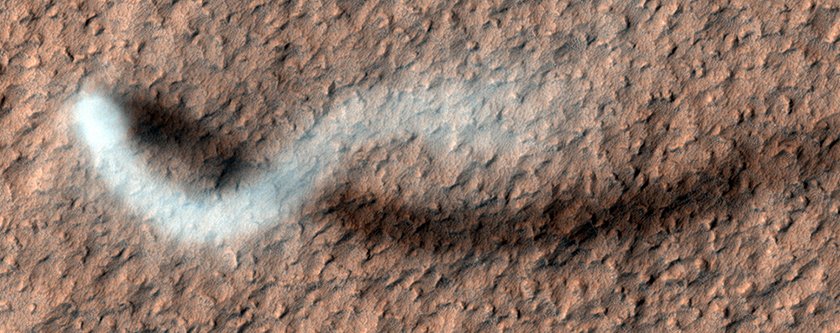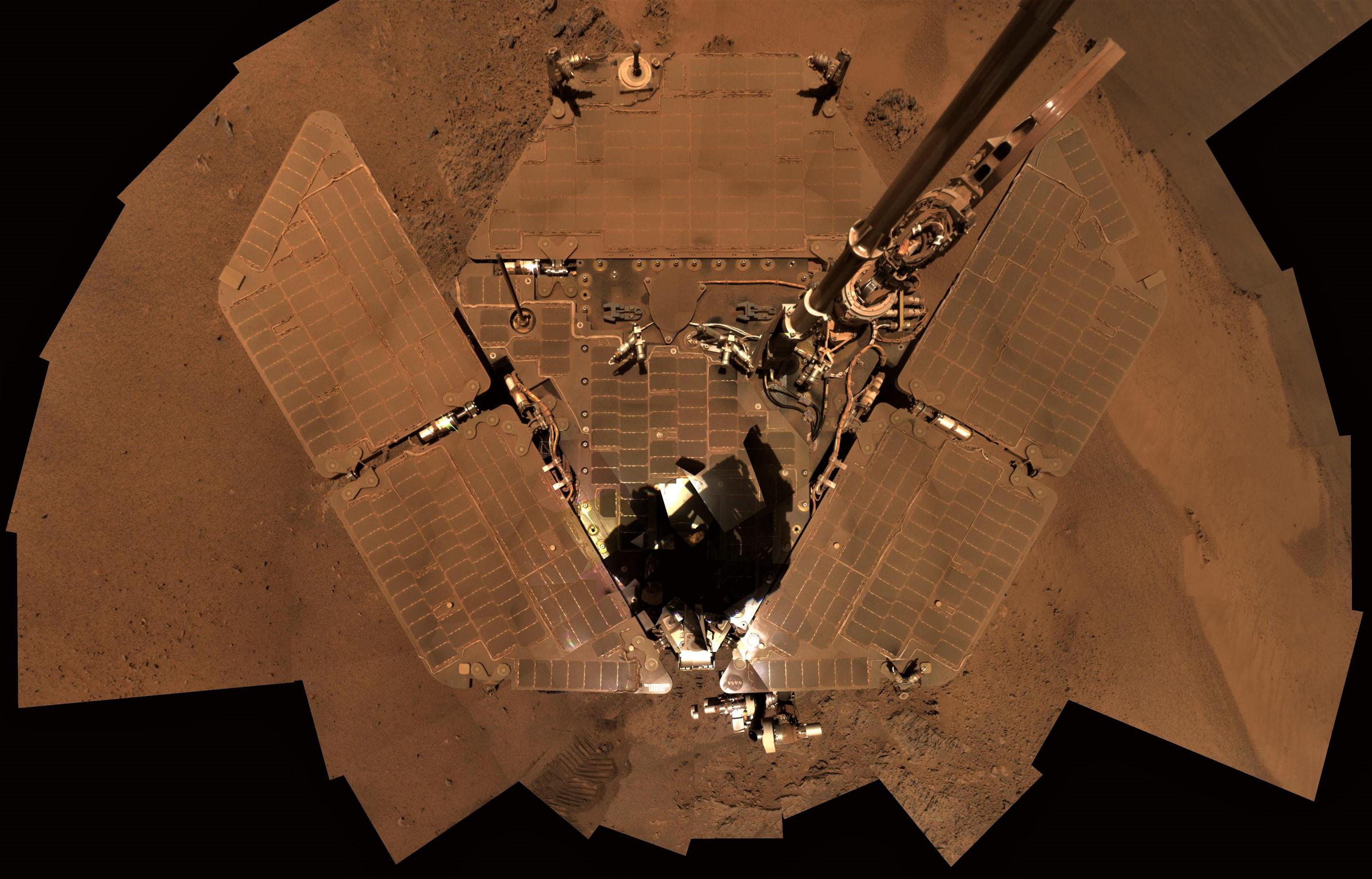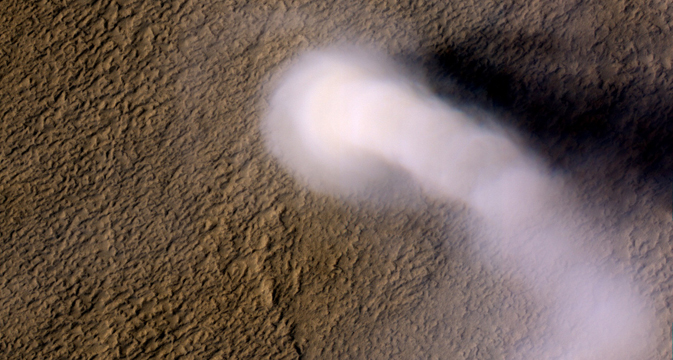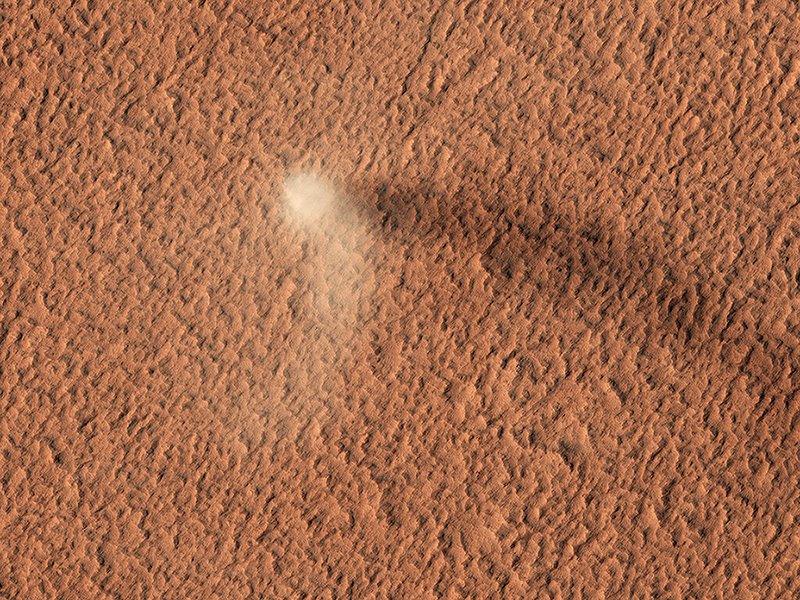

News
Martian dust storms are driving away spacecraft-saving dust devils
Dust devils are pretty common on Mars – the Red Planet is, after all, a very dusty and windy place. What’s a bit more rare is capturing one of the whirling devils on film. That’s because they fade away nearly as quickly as they appear.
But in October 2019, NASA’s Mars Reconnaissance Orbiter managed to snap a photo of a massive dust devil in action, courtesy of the Mars Reconnaissance Orbiter’s High Resolution Imaging Science Experiment (HiRISE), a powerful camera that’s been snapping photos of the Martian surface since 2006.
NASA’s first glimpse of one of these dust storms came in 1971 when the Mariner 9 spacecraft — the first to orbit another planet — arrived at the red planet. Since then, we’ve seen quite a few of these dusty spectacles global storms: in 1977 (twice), 1982, 1994, 2001, 2007 and 2018.

In 2018, we lost the Opportunity rover to the strongest dust storm ever observed on Mars. It blotted out nearly all of the sun’s light for several weeks, turning day into night and preventing the rover from being able to charge its batteries. (Opportunity and its twin, Spirit, ran on solar power, as opposed to Curiosity and the Mars 2020 rover, which run on nuclear power.)
Martian dust storms are common, especially at specific times in the year, like during the southern hemisphere’s spring and summer. Localized storms tend to last a couple of days and can cover regions of the planet the size of the United States. But planet-encircling ones are a different story.
These massive, global storms are usually unpredictable, and can linger for months at a time. “We still don’t know what drives the variability, but the 2018 storm gives another data point,” says Scott Guzewich, an atmospheric scientist at NASA’s Goddard Space Flight Center in Greenbelt, Maryland, who’s a lead in NASA’s dust storm investigation.

Dust devils are rotating columns of air and dust that form when hot air from the surface rises. The current of air created forms a whirlwind, which can be useful for clearing off solar panels on spacecraft as they pass over.
As we move towards potential human missions we need to know how the dust will affect astronauts as well as their equipment. Understanding how often these phenomena occur will be extremely helpful for future missions.
During the dust storm of 2018, Curiosity was able to collect data about the storm, watching as its effects were felt half a world away from where Opportunity sat, hunkered down and hibernating.
Curiosity discovered that dust devils disappear during a dust storm, which happens to be when we need them the most. And they’re gone for several months afterwards as well. This is because the storm interrupts the wind-generating processes that spawn the dust devils.
According to Guzewich, understanding a global storm’s impact on dust devils is a crucial component in planning how to manage equipment during future Mars missions. “You need to be prepared to go a while before your next dust devil passes over and cleans you off,” he said.

Researchers at the University of Arizona recently published details on a newly photographed dust devil, which formed on the volcanic plains of Amazonis Planitia.
According to the HiRISE imaging team, the core of the dust devil is 164 feet (50 meters) wide, and probably about 2,32 feet (650 meters) tall. As massive as it sounds, there are even larger ones whirling around.
In March 2012, HiRISE took a photo of an active dust devil that was a whopping 12 miles (20 kilometers) tall. But was only slightly wider than the most recent one, at just over 229 feet (70 meters) wide.
For the first time, humanity has a fleet of spacecraft orbiting Mars as well as one rover roaming the surface right now (with two more to follow in the coming months). With their help, scientists will be able to better understand this puzzling phenomenon.
News
Tesla cleared in Canada EV rebate investigation
Tesla has been cleared in an investigation into the company’s staggering number of EV rebate claims in Canada in January.

Canadian officials have cleared Tesla following an investigation into a large number of claims submitted to the country’s electric vehicle (EV) rebates earlier this year.
Transport Canada has ruled that there was no evidence of fraud after Tesla submitted 8,653 EV rebate claims for the country’s Incentives for Zero-Emission Vehicles (iZEV) program, as detailed in a report on Friday from The Globe and Mail. Despite the huge number of claims, Canadian authorities have found that the figure represented vehicles that had been delivered prior to the submission deadline for the program.
According to Transport Minister Chrystia Freeland, the claims “were determined to legitimately represent cars sold before January 12,” which was the final day for OEMs to submit these claims before the government suspended the program.
Upon initial reporting of the Tesla claims submitted in January, it was estimated that they were valued at around $43 million. In March, Freeland and Transport Canada opened the investigation into Tesla, noting that they would be freezing the rebate payments until the claims were found to be valid.
READ MORE ON ELECTRIC VEHICLES: EVs getting cleaner more quickly than expected in Europe: study
Huw Williams, Canadian Automobile Dealers Association Public Affairs Director, accepted the results of the investigation, while also questioning how Tesla knew to submit the claims that weekend, just before the program ran out.
“I think there’s a larger question as to how Tesla knew to run those through on that weekend,” Williams said. “It doesn’t appear to me that we have an investigation into any communication between Transport Canada and Tesla, between officials who may have shared information inappropriately.”
Tesla sales have been down in Canada for the first half of this year, amidst turmoil between the country and the Trump administration’s tariffs. Although Elon Musk has since stepped back from his role with the administration, a number of companies and officials in Canada were calling for a boycott of Tesla’s vehicles earlier this year, due in part to his association with Trump.
News
Tesla Semis to get 18 new Megachargers at this PepsiCo plant
PepsiCo is set to add more Tesla Semi Megachargers, this time at a facility in North Carolina.

Tesla partner PepsiCo is set to build new Semi charging stations at one of its manufacturing sites, as revealed in new permitting plans shared this week.
On Friday, Tesla charging station scout MarcoRP shared plans on X for 18 Semi Megacharging stalls at PepsiCo’s facility in Charlotte, North Carolina, coming as the latest update plans for the company’s increasingly electrified fleet. The stalls are set to be built side by side, along with three Tesla Megapack grid-scale battery systems.
The plans also note the faster charging speeds for the chargers, which can charge the Class 8 Semi at speeds of up to 1MW. Tesla says that the speed can charge the Semi back to roughly 70 percent in around 30 minutes.
You can see the site plans for the PepsiCo North Carolina Megacharger below.

Credit: PepsiCo (via MarcoRPi1 on X)

Credit: PepsiCo (via MarcoRPi1 on X)
READ MORE ON THE TESLA SEMI: Tesla to build Semi Megacharger station in Southern California
PepsiCo’s Tesla Semi fleet, other Megachargers, and initial tests and deliveries
PepsiCo was the first external customer to take delivery of Tesla’s Semis back in 2023, starting with just an initial order of 15. Since then, the company has continued to expand the fleet, recently taking delivery of an additional 50 units in California. The PepsiCo fleet was up to around 86 units as of last year, according to statements from Semi Senior Manager Dan Priestley.
Additionally, the company has similar Megachargers at its facilities in Modesto, Sacramento, and Fresno, California, and Tesla also submitted plans for approval to build 12 new Megacharging stalls in Los Angeles County.
Over the past couple of years, Tesla has also been delivering the electric Class 8 units to a number of other companies for pilot programs, and Priestley shared some results from PepsiCo’s initial Semi tests last year. Notably, the executive spoke with a handful of PepsiCo workers who said they really liked the Semi and wouldn’t plan on going back to diesel trucks.
The company is also nearing completion of a higher-volume Semi plant at its Gigafactory in Nevada, which is expected to eventually have an annual production capacity of 50,000 Semi units.
Tesla executive teases plan to further electrify supply chain
News
Tesla sales soar in Norway with new Model Y leading the charge
Tesla recorded a 54% year-over-year jump in new vehicle registrations in June.

Tesla is seeing strong momentum in Norway, with sales of the new Model Y helping the company maintain dominance in one of the world’s most electric vehicle-friendly markets.
Model Y upgrades and consumer preferences
According to the Norwegian Road Federation (OFV), Tesla recorded a 54% year-over-year jump in new vehicle registrations in June. The Model Y led the charge, posting a 115% increase compared to the same period last year. Tesla Norway’s growth was even more notable in May, with sales surging a whopping 213%, as noted in a CNBC report.
Christina Bu, secretary general of the Norwegian EV Association (NEVA), stated that Tesla’s strong market performance was partly due to the updated Model Y, which is really just a good car, period.
“I think it just has to do with the fact that they deliver a car which has quite a lot of value for money and is what Norwegians need. What Norwegians need, a large luggage space, all wheel drive, and a tow hitch, high ground clearance as well. In addition, quite good digital solutions which people have gotten used to, and also a charging network,” she said.
Tesla in Europe
Tesla’s success in Norway is supported by long-standing government incentives for EV adoption, including exemptions from VAT, road toll discounts, and access to bus lanes. Public and home charging infrastructure is also widely available, making the EV ownership experience in the country very convenient.
Tesla’s performance in Europe is still a mixed bag, with markets like Germany and France still seeing declines in recent months. In areas such as Norway, Spain, and Portugal, however, Tesla’s new car registrations are rising. Spain’s sales rose 61% and Portugal’s sales rose 7% last month. This suggests that regional demand may be stabilizing or rebounding in pockets of Europe.
-

 Elon Musk2 weeks ago
Elon Musk2 weeks agoTesla investors will be shocked by Jim Cramer’s latest assessment
-

 Elon Musk2 days ago
Elon Musk2 days agoxAI launches Grok 4 with new $300/month SuperGrok Heavy subscription
-

 Elon Musk4 days ago
Elon Musk4 days agoElon Musk confirms Grok 4 launch on July 9 with livestream event
-

 News1 week ago
News1 week agoTesla Model 3 ranks as the safest new car in Europe for 2025, per Euro NCAP tests
-

 Elon Musk2 weeks ago
Elon Musk2 weeks agoA Tesla just delivered itself to a customer autonomously, Elon Musk confirms
-

 Elon Musk1 week ago
Elon Musk1 week agoxAI’s Memphis data center receives air permit despite community criticism
-

 News2 weeks ago
News2 weeks agoXiaomi CEO congratulates Tesla on first FSD delivery: “We have to continue learning!”
-

 Investor's Corner2 weeks ago
Investor's Corner2 weeks agoTesla gets $475 price target from Benchmark amid initial Robotaxi rollout

















